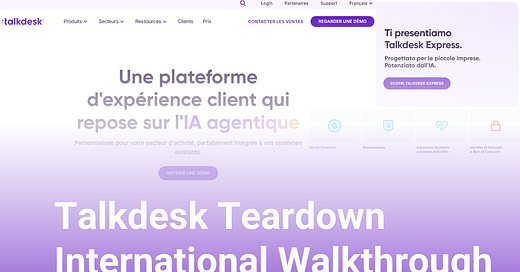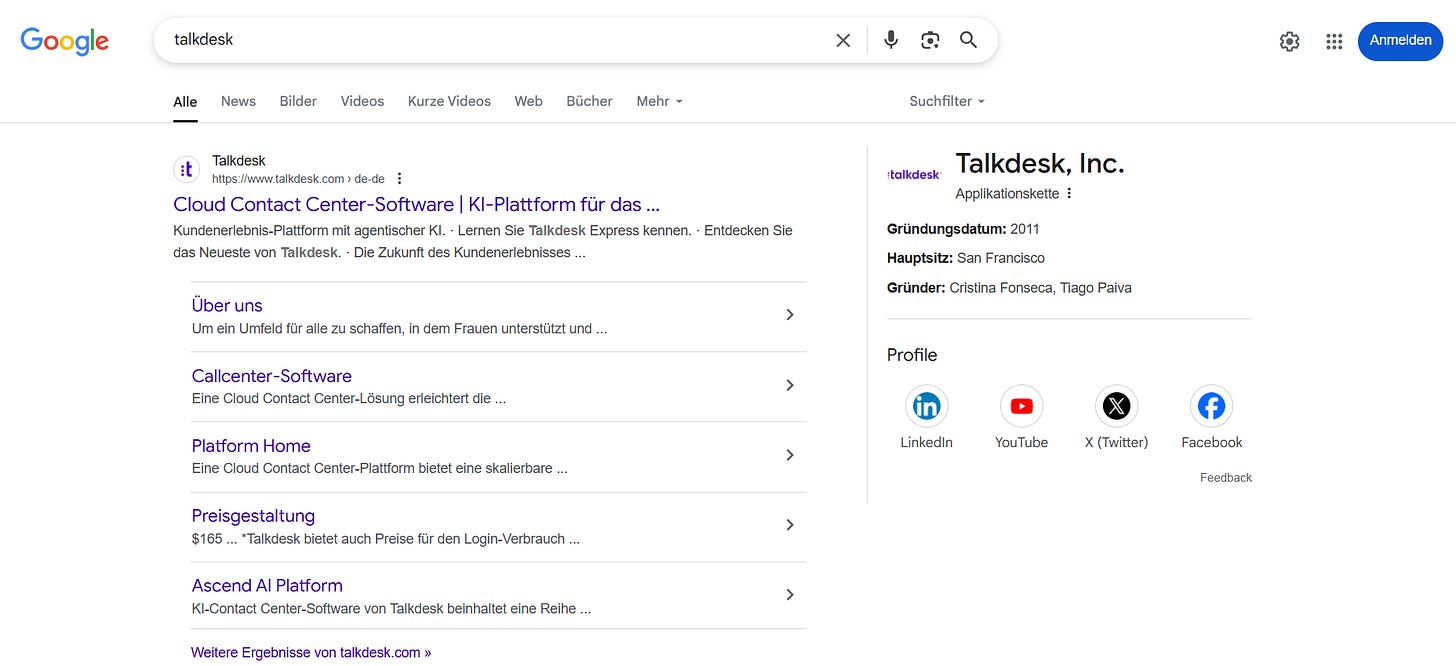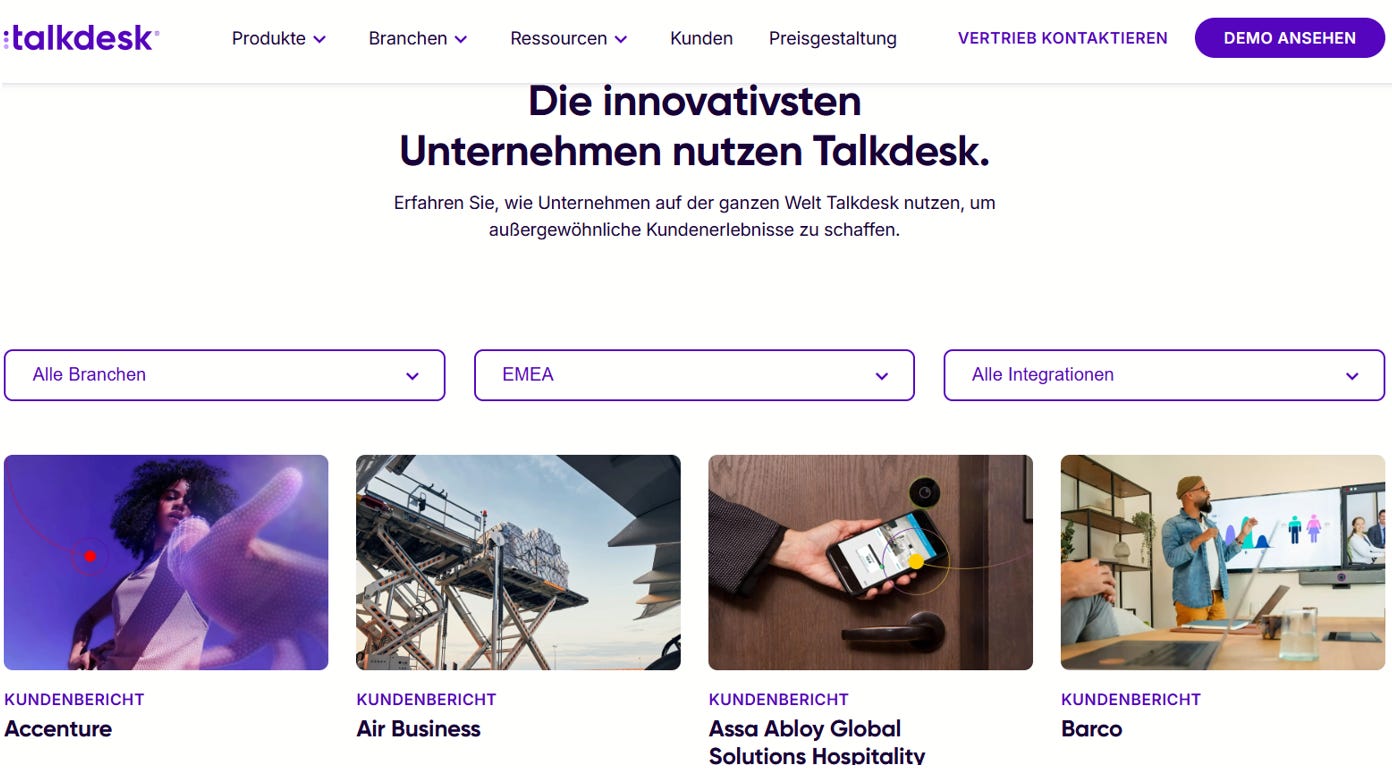Talkdesk Teardown: International Walkthrough
How effective is Talkdesk's international user experience?
Talkdesk, founded in 2011, delivers call center software to businesses in over 100 countries. Talkdesk primarily sells to enterprises and leans heavily on a partner-led growth model, aided by direct sales. Having raised over $500m at a $10b valuation, they have over 1300 employees currently.
For sales-led and partner-led companies, their international website exists to establish credibility and trust, and to augment human-led sales processes. Talkdesk localizes its website into 6 languages (French, German, Italian, Portuguese-Brazil, Portuguese-Portugal, Spanish). Let’s walk through the experience and determine how it might make improvements.
Navigation
Most website journeys commence with a search. When searching with a German IP location, Talkdesk is correctly configured to deliver its German experience:
Best Practice: ensure your website SEO architecture and settings deliver a native search experience across all languages
Interestingly, Talkdesk advertises in both English and native languages across Google. Here’s a selection of the Google search ads recently displayed for Talkdesk in France:
The multiple, localized search ads don’t always lead to a localized landing page, which is problematic. Here’s an example of a Google ad for a Talkdesk demo, which directs the user to an English-only experience:
For partner-led companies, this experience is a problem because prospects are very likely to seek information and demos about the product independently.
Room for Improvement: audit the search advertising experience to ensure it matches user location and language
When landing onto talkdesk.com, English is displayed by default, regardless of browser language preference or IP location. This is far from ideal, as it immediately places a burden on users to find their native language.
Room for Improvement: lower user experience friction by always defaulting to their preferred browser language
As a counterpoint, Talkdesk does make it easy to switch language by including a language selector prominently in its website header:
Best Practice: always include a language selector in the page header for convenient access and usability
Hyper-Localization
Hyper-localization involves tailoring the localized experience for users based on their geographic location. It helps achieve a more immersive experience, much more deeply than a simple localization effort. Let’s review where Talkdesk utilizes hyper-localization and what additional opportunities is has.
Customer Stories
Talkdesk highlights some of its local customers on its respective localized websites. This is an excellent way to leverage social proof and enhance its credibility.
Here’s how it displays local customer logos on its German, Portuguese-Brazilian and French websites, respectively:
Best Practice: tailor customer logos for each market by highlighting local customers and maximizing social proof
The hyper-localization doesn’t extend far from here. When seeking more customer stories, the case studies page displays the same set of stories, regardless of language or location:
There’s an option to filter the stories by region (EMEA or Americas), which is an add experience. Typically, these regions reflect sales organization, rather than how individuals think about their part of the world. A naming structure such as “Europe” and “North America” would make more sense here.
After filtering to one of the regions, the majority of the case studies are presented in English-only, which is less than ideal.
Room for Improvement: ensure case studies are presented aligned with user location and fully localized
Security & Trust
Enterprise software frequently differentiates itself from competitors on its security credentials and trustworthiness. Procurement processes typically involve security reviews, so any reduction in friction can accelerate the sales cycle. Talkdesk has a Security page, but is hard to find and doesn’t vary by market.
This represents an improvement opportunity. For example, prospective customers in Germany will be interested in German-specific credentials and certification. Furthermore, highlighting privacy and security credentials on the German homepage would likely improve engagement and lead flow.
Room for Improvement: tailor the security page by market to highlight local privacy and security compliance. Feature certificates and credentials on the homepage for security-conscious markets, such as Germany.
An ebook is available for more security details, but it appears to be English-only:
Local Events
Hosting local webinars is a proven strategy for driving engagement across global markets. While Talkdesk doesn’t appear to host local webinars, it’s also missing out on the opportunity to present its English-language webinars in multiple languages:
Each of the webinar recordings appears to be English-only. There are multiple solutions available to localize the audio track into different languages with low cost and effort.
Room for Improvement: offer webinars in local languages with AI video technology
Usability
Talkdesk has some room to improve the overall international user experience by creating a more immersive, fully localized journey.
The localized homepage features a prominent video, with partially localized text overlaid on English product screenshots:
Room for Improvement: use localized screenshots to match user language expectations in demo images and videos
Talkdesk offers live chat support on its website. This feature is proven as a driver of engagement and leads. However, although Talkdesk seems to offer German chat support on some pages, the default prompt on its localized homepage is English-only:
Room for Improvement: Use localized chat prompts and interaction to increase engagement and lead flow for international customers
Helping customers understand their expected ROI is a key challenge for any B2B company. Talkdesk leans into this with a value calculator, which purports to help customers understand their likely value based on contact center agents. While great in principle, this is currently English-only:
Room for Improvement: adapt ROI tools for international customers to demonstrate efficacy and credibility
Although Talkdesk is not product-led in its go-to-market motion, it helpfully displays pricing information, but only in US Dollars. It’s not clear if this is an oversight or actually reflects consistent pricing and currency support across all markets:
Room for Improvement: demonstrate pricing and currency in local currency to reduce cognitive load and help customer assessment
For enterprise products, interactive demos can play a role in bridging the knowledge gap for new customers. Talkdesk offers multiple interactive user demos, but misses the opportunity to present them in local languages:
Room for Improvement: showcase product demos in local languages to complement the website experience
Talkdesk is rolling out a new product, Talkdesk Express, for smaller organizations. While it appears to be product-led-growth, it’s currently limited to customers in the USA and Canada (although curiously, not in French for Canada). It’s also available via partners for international customers.
Considering Talkdesk is partner-led, the experience of finding a local partner could be vastly improved. While most partners will have their own book of customers, any potential prospect seeking a local partner will have to hunt through a maze of sales-organization groupings to find a suitable option:
Room for Improvement: organize partners by-country and default to local partners based on customer’s IP address. Use real-world regions (or better, countries) instead of sales territory naming conventions
Wrap Up
Talkdesk has achieved strong success domestically and internationally so far, but has much room to improve its international go-to-market and website experience. It can significantly improve how it informs, reassures and interacts with customers locally by fixing key localization gaps and tailoring the experience based on location.
It’s likely that further international expansion is on the horizon for Talkdesk, but prior to adding more languages or markets, it would be advisable to optimize its current experience and establish an international user experience that will scale appropriately to new markets - particularly if it has ambitions for Japan and other Asian markets.






















